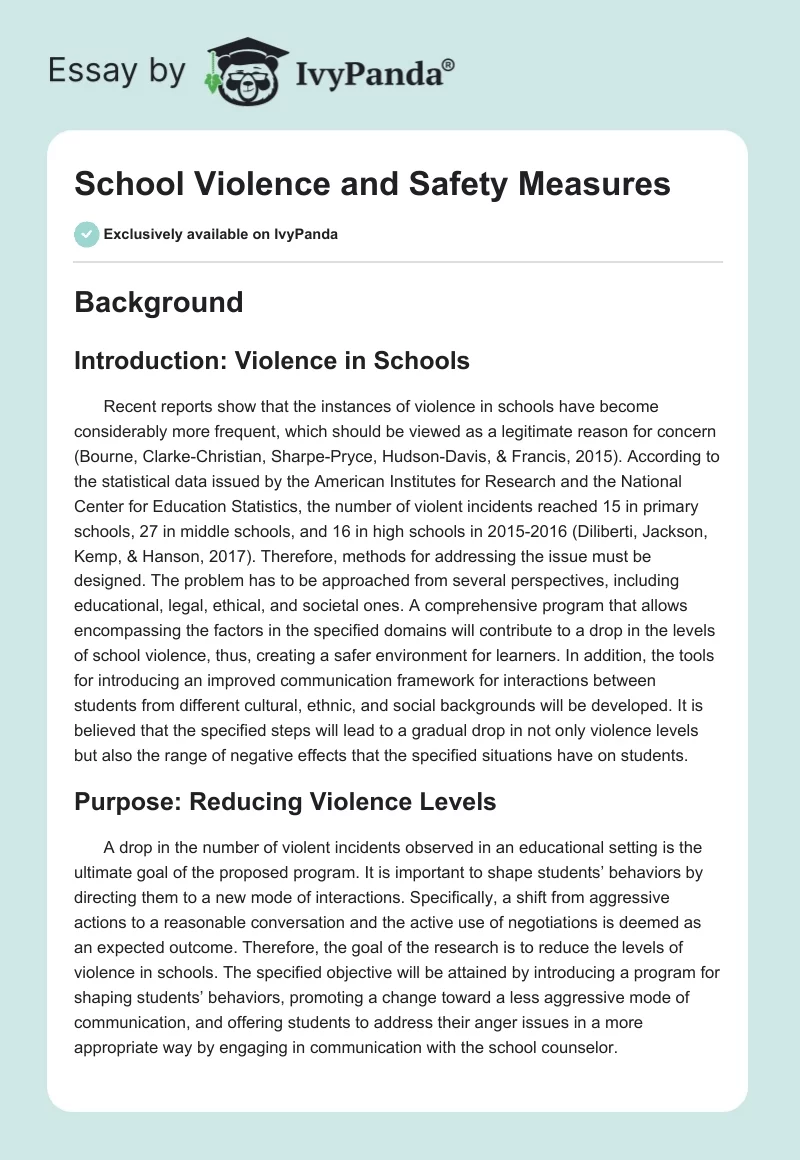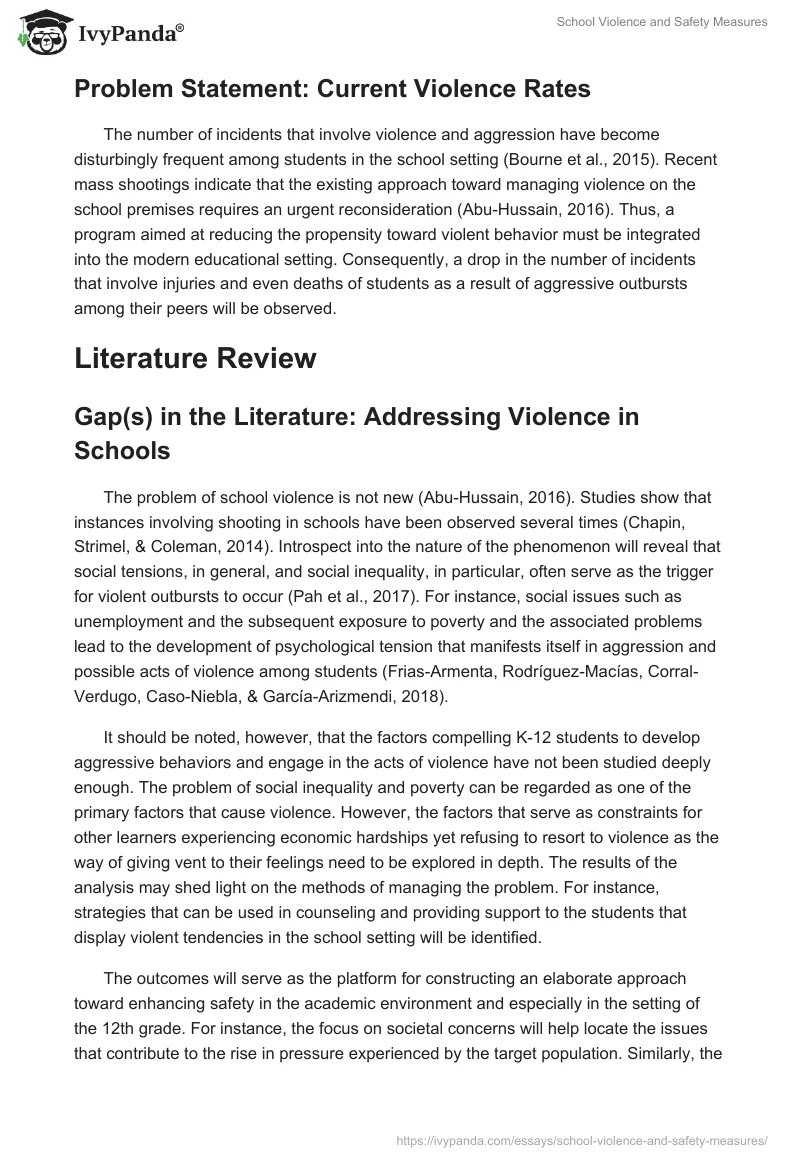Background
Introduction: Violence in Schools
Recent reports show that the instances of violence in schools have become considerably more frequent, which should be viewed as a legitimate reason for concern (Bourne, Clarke-Christian, Sharpe-Pryce, Hudson-Davis, & Francis, 2015). According to the statistical data issued by the American Institutes for Research and the National Center for Education Statistics, the number of violent incidents reached 15 in primary schools, 27 in middle schools, and 16 in high schools in 2015-2016 (Diliberti, Jackson, Kemp, & Hanson, 2017). Therefore, methods for addressing the issue must be designed. The problem has to be approached from several perspectives, including educational, legal, ethical, and societal ones. A comprehensive program that allows encompassing the factors in the specified domains will contribute to a drop in the levels of school violence, thus, creating a safer environment for learners. In addition, the tools for introducing an improved communication framework for interactions between students from different cultural, ethnic, and social backgrounds will be developed. It is believed that the specified steps will lead to a gradual drop in not only violence levels but also the range of negative effects that the specified situations have on students.
Purpose: Reducing Violence Levels
A drop in the number of violent incidents observed in an educational setting is the ultimate goal of the proposed program. It is important to shape students’ behaviors by directing them to a new mode of interactions. Specifically, a shift from aggressive actions to a reasonable conversation and the active use of negotiations is deemed as an expected outcome. Therefore, the goal of the research is to reduce the levels of violence in schools. The specified objective will be attained by introducing a program for shaping students’ behaviors, promoting a change toward a less aggressive mode of communication, and offering students to address their anger issues in a more appropriate way by engaging in communication with the school counselor.
Problem Statement: Current Violence Rates
The number of incidents that involve violence and aggression have become disturbingly frequent among students in the school setting (Bourne et al., 2015). Recent mass shootings indicate that the existing approach toward managing violence on the school premises requires an urgent reconsideration (Abu-Hussain, 2016). Thus, a program aimed at reducing the propensity toward violent behavior must be integrated into the modern educational setting. Consequently, a drop in the number of incidents that involve injuries and even deaths of students as a result of aggressive outbursts among their peers will be observed.
Literature Review
Gap(s) in the Literature: Addressing Violence in Schools
The problem of school violence is not new (Abu-Hussain, 2016). Studies show that instances involving shooting in schools have been observed several times (Chapin, Strimel, & Coleman, 2014). Introspect into the nature of the phenomenon will reveal that social tensions, in general, and social inequality, in particular, often serve as the trigger for violent outbursts to occur (Pah et al., 2017). For instance, social issues such as unemployment and the subsequent exposure to poverty and the associated problems lead to the development of psychological tension that manifests itself in aggression and possible acts of violence among students (Frias-Armenta, Rodríguez-Macías, Corral-Verdugo, Caso-Niebla, & García-Arizmendi, 2018).
It should be noted, however, that the factors compelling K-12 students to develop aggressive behaviors and engage in the acts of violence have not been studied deeply enough. The problem of social inequality and poverty can be regarded as one of the primary factors that cause violence. However, the factors that serve as constraints for other learners experiencing economic hardships yet refusing to resort to violence as the way of giving vent to their feelings need to be explored in depth. The results of the analysis may shed light on the methods of managing the problem. For instance, strategies that can be used in counseling and providing support to the students that display violent tendencies in the school setting will be identified.
The outcomes will serve as the platform for constructing an elaborate approach toward enhancing safety in the academic environment and especially in the setting of the 12th grade. For instance, the focus on societal concerns will help locate the issues that contribute to the rise in pressure experienced by the target population. Similarly, the problems associated with gender-related violence in schools will be scrutinized closely to determine the effects of gender-related conflicts on the propensity toward violence among K-12 students (Meyer & Chetty, 2017). Thus, a more detailed analysis is required.
The specified perspective will allow promoting well-being among vulnerable populations, thus, helping students eradicate the problem as opposed to stifling it. Particularly, to manage the issue of aggressive and violent behaviors among K-12 students, one should focus on rehabilitation rather than punishment. However, an overview of recent research on the subject matter shows that very little progress has been made in the specified area since most strategies against gun violence and similar instances of aggression are geared primarily toward restricting target students’ ability to express their emotions (Diliberti et al., 2017). Thus, students showing the tendency to use aggression while communicating with others have to be given an opportunity to realize that the emotions that they keep concealed can be expressed in a much healthier way.
Research Question: How Violence Rates Can Be Reduced
What social, economic, and cultural factors need to be incorporated into the program aimed at altering the behaviors of K-12 students that show the propensity toward violence?
Proposed Theory: Managing the Social Conflict
In order to explore the problem of school violence as a multifaceted phenomenon, one will have to apply several theories. Particularly, the theory of social conflict will have to be used to discuss the effects that social differences have on students’ emotions, attitudes toward their peers, etc. Thus, the social perspective will be encompassed. In addition, it is desirable to adopt a modern approach as the means of supporting the theoretical framework for the analysis. For this purpose, Mill’s Modern Conflict Theory will have to be incorporated into the analysis. The proposed approach points to the necessity to focus on the distribution of resources as the basis for the development of confrontations between different social, ethnic, and cultural groups (Andreou, 2014). Consequently, the platform for an in-depth analysis of the multiple factors affecting the choice of behaviors made by K-12 students in the school setting will be built.
The theoretical framework used for the research will incorporate the elements of both theories mentioned above. Therefore, a wide range of factors that affect the further development of the required behaviors in students with aggression issues will be identified and embraced. The incorporation of both theories will give an opportunity to establish a more rigid control over the changes that the target population will experience. Thus, successful outcomes can be expected.
References
Abu-Hussain, J. (2016). The role of bibliotherapy in reduction of violence in Arab schools in Israel. American Journal of Educational Research, 4(10), 725-730.
Andreou, E. (2014). School violence prevention: The youth development perspective. British Journal of Education, Society & Behavioural Science, 5(4), 389-395.
Bourne, P. A., Clarke-Christian, J., Sharpe-Pryce, C., Hudson-Davis, A., & Francis, C. (2015). Strategies in dealing with violence in schools: Perceived effectiveness of conflict management strategies used by education leaders in reducing students’ disagreements. Psychiatry, 18(248), 2-13.
Chapin, J., Strimel, L., & Coleman, G. (2014). It won’t happen to me: Addressing adolescents’ risk perception of dating violence. International Journal of Violence and Schools, 14, 44-54.
Diliberti, M., Jackson, M., Kemp, J., & Hanson, R. (2017).Crime, violence, discipline, and safety in U.S. public schools: Findings from the school survey on crime and safety: 2015–16. First look. Web.
Frias-Armenta, M., Rodríguez-Macías, J. C., Corral-Verdugo, V., Caso-Niebla, J., & García-Arizmendi, V. (2018). Restorative justice: A model of school violence prevention. Science, 6(1), 39-45.
Meyer, L., & Chetty, R. (2017). Violence in schools: A holistic approach to personal transformation of at-risk youth. Acta Criminologica: Southern African Journal of Criminology, 30(3), 121-134.
Pah, A. R., Hagan, J., Jennings, A. L., Jain, A., Albrecht, K., Hockenberry, A. J., & Amaral, L. A. N. (2017). Economic insecurity and the rise in gun violence at US schools. Nature Human Behaviour, 1(2), 1-6.


